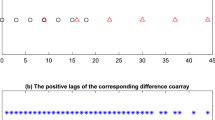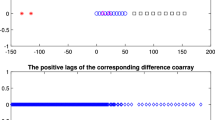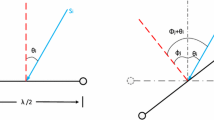Abstract
In this paper, two-dimensional (2-D) direction-of-arrival (DOA) estimation issue is investigated by constructing array model on moving platform. Based on the moving array model, we propose two improved three-parallel coprime arrays (TPCPAs), which utilize the redundancy in the physical structure of moving TPCPA (MTPCPA) and are able to generate the same virtual array as MTPCPA using much fewer sensors. Accordingly, higher sensor utilization is achieved by the proposed arrays, which can contribute to the increase in the number of degrees of freedom. Besides, with the proposed arrays, we also present a 2-D off-grid DOA estimation algorithm, in which the estimated 2-D angles are automatically paired without extra pairing procedure. Particularly, by utilizing the \({\ell }_{p}(0<p<1)\) norm and majorization–minimization method jointly, the proposed algorithm solves the grid mismatch problem effectively and accordingly enhances the 2-D DOA estimation performance. Finally, numerical simulations demonstrate the effectiveness and superiority of the proposed arrays and 2-D off-grid DOA estimation algorithm.












Similar content being viewed by others
References
S. Boyd, L. Vandenberghe, Convex Optimization (Cambridge University Press, Cambridge, 2004)
J. Dai, X. Bao, W. Xu, C. Chang, Root sparse Bayesian learning for off-grid DOA estimation. IEEE Signal Process. Lett. 24(1), 46–50 (2017)
X. Fu, R. Cao, F. Wen, A de-noising 2-D-DOA estimation method for uniform rectangle array. IEEE Commun. Lett. 22(9), 1854–1857 (2018)
P. Gong, X. Zhang, J. Shi, W. Zheng, Three-parallel co-prime array configuration for two-dimensional DOA estimation, in 9th International Conference on Wireless Communications and Signal Processing, pp. 1–5 (2017)
J. Li, D. Jiang, Joint elevation and azimuth angles estimation for L-shaped array. IEEE Antennas Wireless Propag. Lett. 16, 453–456 (2017)
J. Li, D. Jiang, X. Zhang, Sparse representation based two-dimensional direction of arrival estimation using co-prime array. Multidimensional Syst. Signal Process. 29(1), 35–47 (2018)
J. Li, Y. Li, X. Zhang, Two-dimensional off-grid DOA estimation using unfolded parallel coprime array. IEEE Commun. Lett. 22(12), 2495–2498 (2018)
J. Li, X. Zhang, Two-dimensional grid-less angle estimation based on three parallel nested arrays. Signal Process. 173, 107577 (2020)
C.P. Mathews, M.D. Zoltowski, Eigenstructure techniques for 2-D angle estimation with uniform circular arrays. IEEE Trans. Signal Process. 42(9), 2395–2407 (1994)
M. Malek-Mohammadi, M. Babaie-Zadeh, M. Skoglund, Performance guarantees for schatten-p quasi-norm minimization in recovery of low-rank matrices. Signal Process. 114, 225–230 (2015)
P. Pal, P.P. Vaidyanathan, Coprime sampling and the MUSIC algorithm, in Digital Signal Processing and Signal Processing Education Meeting, pp. 289–294 (2011)
P. Pal, P.P. Vaidyanathan, Nested arrays: a novel approach to array processing with enhanced degrees of freedom. IEEE Trans. Signal Process. 58(8), 4167–4181 (2010)
S. Qin, Y.D. Zhang, M.G. Amin, Two-dimensional DOA estimation using parallel coprime subarrays, in Proceedings of IEEE Sensor Array and Multichannel Signal Processing Workshop, pp. 1–4 (2016)
G. Qin, M.G. Amin, Y.D. Zhang, DOA estimation exploiting sparse array motions. IEEE Trans. Signal Process. 67(11), 3013–3027 (2019)
A. Rakotomamonjy, R. Flamary, G. Gasso, S. Canu, \(\ell _{p}-\ell _{q}\) penalty for sparse linear and sparse multiple kernel multitask learning. IEEE Trans. Neural Netw. 22(8), 1307–1320 (2011)
J. Shi, G. Hu, X. Zhang, F. Sun, H. Zhou, Sparsity-based two-dimensional DOA estimation for coprime array: from sum-difference coarray viewpoint. IEEE Trans. Signal Process. 65(21), 5591–5604 (2017)
F. Shen, Y. Liu, G. Zhao, X. Chen, X. Li, Sparsity-based off-grid DOA estimation with uniform rectangular arrays. IEEE Sens. J. 18(8), 3384–3390 (2018)
S. Stergiopoulos, E.J. Sullivan, Extended towed array processing by an overlap correlator. J. Acoust. Soc. Am. 86(1), 158–171 (1989)
X. Wu, W. Zhu, J. Yan, Direction of arrival estimation for off-grid signals based on sparse Bayesian learning. IEEE Sens. J. 16(7), 2004–2016 (2016)
B. Wang, Y. Gu, W. Wang, Off-grid direction-of-arrival estimation based on steering vector approximation. Circuits Syst. Signal Process. 38(3), 1287–1300 (2019)
X. Wu, W. Zhu, J. Yan, A fast gridless covariance matrix reconstruction method for one- and two-dimensional direction-of-arrival estimation. IEEE Sens. J. 17(15), 4916–4927 (2017)
X. Wu, W. Zhu, J. Yan, Z. Zhang, Two sparse-based methods for off-grid direction-of-arrival estimation. Signal Process. 142, 87–95 (2018)
Z. Xu, X. Chang, F. Xu, H. Zhang, \(l_{1/2}\) regularization: A thresholding representation theory and a fast solver. IEEE Trans. Neural Netw. Learn. Syst. 23(7), 1013–1027 (2012)
Q.Y. Yin, R.W. Newcomb, L.H. Zou, Estimating 2-D angles of arrival via two parallel linear arrays, in IEEE International Conference on Acoustics, Speech, and Signal Processing, pp. 2803–2806 (1989)
Z. Yang, L. Xie, C. Zhang, Off-grid direction of arrival estimation using sparse Bayesian inference. IEEE Trans. Signal Process. 61(1), 38–43 (2013)
T.J. Yen et al., A majorization-minimization approach to variable selection using spike and slab priors. Ann. Stat. 39(3), 1748–1775 (2011)
Z. Zheng, W. Wang, H. Meng, H.C. So, H. Zhang, Efficient beamspace-based algorithm for two-dimensional DOA estimation of incoherently distributed sources in massive MIMO systems. IEEE Trans. Veh. Technol. 67(12), 11776–11789 (2018)
Z. Zheng, Y. Yang, W. Wang, S. Zhang, Two-dimensional direction estimation of multiple signals using two parallel sparse linear arrays. Signal Process. 143, 112–121 (2018)
Y. Zhang, X. Xu, Y.A. Sheikh, Z. Ye, A rank-reduction based 2-D DOA estimation algorithm for three parallel uniform linear arrays. Signal Process. 120, 305–310 (2016)
Z. Zheng, W. Wang, Y. Kong, Y.D. Zhang, MISC array: a new sparse array design achieving increased degrees of freedom and reduced mutual coupling effect. IEEE Trans. Signal Process. 67(7), 1728–1741 (2019)
Z. Zheng, S. Mu, Two-dimensional DOA estimation using two parallel nested arrays. IEEE Commun. Lett. 24(3), 568–571 (2020)
C. Zhou, Y. Gu, X. Fan, Z. Shi, G. Mao, Y.D. Zhang, Direction-of-arrival estimation for coprime array via virtual array interpolation. IEEE Trans. Signal Process. 66(22), 5956–5971 (2018)
C. Zhou, Y. Gu, Z. Shi, Y.D. Zhang, Off-grid direction-of-arrival estimation using coprime array interpolation. IEEE Signal Process. Lett. 25(11), 1710–1714 (2018)
Acknowledgements
This paper was supported in part by the National Natural Science Foundation of China under Grant 61671168 and Grant 61801143, in part by the National Natural Science Foundation of Heilongjiang Province under Grant LH2019F010, and in part by the Fundamental Research Funds for the Central Universities under Grant 3072019CF0801 and Grant 3072019CFM0802.
Author information
Authors and Affiliations
Corresponding author
Additional information
Publisher's Note
Springer Nature remains neutral with regard to jurisdictional claims in published maps and institutional affiliations.
Appendix: Proof of Proposition 2
Appendix: Proof of Proposition 2
1) First, we will prove that the physical sensors located at \(\{mN\left| {\left\lfloor {{M /2}} \right\rfloor + 1 \le m} \right. \le M\} \) with \(M \ge 2\) in subarray 1 of MTPCPA can be removed without changing the DOFs of resulting virtual array.
Let \(\bar{{\mathbb {D}}}={{\bar{{\mathbb {D}}}}_{1}}\cup {{\bar{{\mathbb {D}}}}_{2}}\), where \({{\bar{{\mathbb {D}}}}_{1}}=\{Mn-Nm\}\), \({{\bar{{\mathbb {D}}}}_{2}}=\{Nm-Mn\}\) for \(0 \le n \le N - 1\), and \(0 \le m \le 2M - 1\). For convenience of expression, we use the index (n, m) to denote the position of virtual sensor located at \(Mn - Nm\). Similarly, the index (m, n) denotes the position of virtual sensor located at \(Nm - Mn\). Then, in the covariance matrix, if two elements with indices \(({n_1},{m_1})\) and \(({n_2},{m_2})\) are complex conjugate, then the following relationship will be satisfied:
Obviously, we can modify (54) as
Since M and N are coprime integers, the condition that equation (55) holds is \({n_1} + {n_2} = N\) and \({m_1} + {m_2} = M\). Then, for a given index \(({n_1},{m_1})\) with \(\left\lfloor {{M/2}} \right\rfloor + 1 \le {m_1} \le M\) and \(1 \le {n_1} \le N - 1\), there will be a corresponding index \(({n_2},{m_2})\) with \({m_2} = M - {m_1}\) in the range \(\left[ {0,M - \left\lfloor {{M/2}} \right\rfloor - 1} \right] \) and \({n_2} = N - {n_1}\) in the range \([1,N - 1]\) satisfying (55). Therefore, the elements in \({\bar{{\mathbb {D}}}_1}\) and \({\bar{{\mathbb {D}}}_2}\) will have the following relationship:
From (56), we can know that \(\bar{{\mathbb {D}}}_1^{({n_1},{m_1})} =\bar{{\mathbb {D}}}_2^{({m_2},{n_2})}\), which indicates that the virtual sensors corresponding to index range \(({n_1},{m_1})\) of \({\bar{{\mathbb {D}}}_1}\) can be found in virtual sensors corresponding to index range \(({m_2},{n_2})\) of \({\bar{{\mathbb {D}}}_2}\). Similarly, the virtual sensors corresponding to index range \(({m_1},{n_1})\) of \({\bar{{\mathbb {D}}}_2}\) can also be found in virtual sensors corresponding to index range \(({n_2},{m_2})\) of \({\bar{{\mathbb {D}}}_1}\). Therefore, physical sensors in subarray 1 and located at \(\{ mN\left| {\left\lfloor {{M/2}} \right\rfloor + 1 \le m} \right. \le M\} \) are redundant, whose removal will not reduce the number of virtual sensors extended under the case that \(n \in [1,N - 1]\).
Now, we will discuss the case that \(n = 0\). If the physical sensors located at \(\{mN|\left\lfloor M/2 \right\rfloor +1\le m\le M\}\) are removed, then the corresponding reduced virtual sensors with \(n = 0\) in the positive range can be represented as \({{\mathbb {L}}^ + } =\{mN\left| {\left\lfloor {{M /2}} \right\rfloor + 1 \le m} \right. \le M\} \). \({{\mathbb {L}}^ - } = \{ - l\left| {l \in {{\mathbb {L}}^ + }} \right. \} \) is the corresponding reduced virtual sensors in the negative range. Similar to the 1-D CPA with \(2M + N -1\) physical sensors, the consecutive part of \(\bar{{\mathbb {D}}}\) lies in the range \({\mathbb {C}} = [ - (MN + M - 1),MN + M - 1]\). Since M and N are coprime integers, and \(M < N\), there is the relationship that \(M \ge 2\). Thereby, the inequality \(MN = \max ({{\mathbb {L}}^ + }) \le MN + M - 1\) will hold. Likewise, \(\min ({{\mathbb {L}}^ - }) = - MN \ge - (MN + M - 1)\) also holds. Therefore, the reduced virtual sensors \({\mathbb {L}} = {{\mathbb {L}}^ + } \cup {{\mathbb {L}}^ - }\) are actually some discontinuous discrete points in the consecutive range of \(\bar{{\mathbb {D}}}\). Besides, according to the analysis in Sect. 3, we can know that the discontinuous holes in the virtual array of the original array can be filled with the virtual sensors increased by array motion. Accordingly, the holes in \({\mathbb {L}}\) caused by the removal of sensors located at \(\{mN\left| {\left\lfloor {{M /2}} \right\rfloor + 1 \le m} \right. \le M\} \) will be filled with the increased virtual sensors due to array motion.
As a conclusion, the physical sensors located at \(\{ mN\left| {\left\lfloor {{M /2}} \right\rfloor + 1 \le m} \right. \le M\} \) with \(M \ge 2\) in subarray 1 of MTPCPA can be removed without changing the resulting virtual array structure.
2) Next, we will prove that the removal of physical sensors located at \(\{ mN\left| {0 \le m} \right. \le \left\lfloor {{M/2}} \right\rfloor \} \) with \(M > 2\) in subarray 1 of MTPCPA will not change the resulting virtual array. And, the proof will be given as follows according to the parity of M.
C1: Consider the case that M is even, where \(\left\lfloor {{M/2}} \right\rfloor \) is thus equal to M/2. For index \(({n_1},{m_1})\) with \(0 \le {m_1} \le {M /2} - 1\) and \(1 \le {n_1} \le N - 1\), there will be a corresponding index \(({n_2},{m_2})\), i.e., \((N -{n_1},M - {m_1})\) with \({m_2}\) in the range \({M/2} + 1 \le {m_2} \le M\) (for even M, \({M /2} + 1\) is equivalent to \(\left\lfloor {{M /2}} \right\rfloor + 1\)) and \({n_2}\) in the range \(1 \le {n_2} \le N - 1\) to make (55) be true. Similarly, the entries corresponding to index \(({n_1},{m_1})\) and \(({n_2},{m_2})\) will satisfy (56). Then, for \(1 \le n \le N - 1\), physical sensors located at \(\{ mN\left| {0 \le m} \right. \le \left\lfloor {{M /2}} \right\rfloor - 1\} \) can be removed without reducing the virtual sensors. Next, we will consider the removal of physical sensor located at \(\{ mN\left| m \right. = \left\lfloor {{M/2}} \right\rfloor = {M /2}\} \) under the case that \(1 \le n \le N -1\), which will result in the generation of holes located at \({{\mathbb {H}}_1} = \{ \pm (Mn - {{MN} /2})\left| {1 \le n} \right. \le N - 1\} \). While under the case that \(n = 0\), the removal of sensors located at \(\{ mN\left| {0 \le m} \right. \le \left\lfloor {{M /2}} \right\rfloor \} \) will lead to the generation of holes located at \({{\mathbb {H}}_2} = \{ \pm Nm\left| {0 \le m} \right. \le {M /2}\} \). Then, all holes can be represented as \({\mathbb {H}} = {{\mathbb {H}}_1} \cup {{\mathbb {H}}_2}\). Since \(\max ({{\mathbb {H}}_1}) = {{MN} /2} - M < MN + M - 1\) and \(\min ({{\mathbb {H}}_1}) = M - {{MN} /2} > - (MN + M - 1)\), \({{\mathbb {H}}_1} \subset {\mathbb {C}}\) holds. Similarly, \(\max ({{\mathbb {H}}_2}) = {{MN} /2} < MN + M - 1\) and \(\min ({{\mathbb {H}}_2}) = {{ - MN} /2} > - (MN + M - 1)\) hold, then \({{\mathbb {H}}_2} \subset {\mathbb {C}}\) is true. Accordingly, \({\mathbb {H}} \subset {\mathbb {C}}\) holds true, which indicates that the holes in \({\mathbb {H}}\) are some discrete points in the consecutive range of \(\bar{{\mathbb {D}}}\). As mentioned before, when the number of consecutive holes does not exceed 2, all of them can be filled with the virtual sensors increased by array motion. Therefore, we will first analyze whether there are three consecutive holes in \({\mathbb {H}}\). For convenience, we use circles and crosses to represent the holes in \({{\mathbb {H}}_1}\) and \({{\mathbb {H}}_2}\), respectively. Then, the relative positions of holes in \({{\mathbb {H}}_1}\) and \({{\mathbb {H}}_2}\) will have the following four cases in Fig. 13.
For Fig. 13a, the spacing between holes 2 and 3 is N unit length, which means that the three holes are discontinuous. Similarly, the distance between holes 2 and 3 in Fig. 13b is M unit length, which indicates that the three holes are also discontinuous. Since the holes in \({\mathbb {H}}\) are mirror-symmetrical with respect to the origin, we just need to analyze the holes of \({\mathbb {H}}\) in the positive range here. For Fig. 13c, we can set the positions of holes 1, 2, and 3 as Nx, \(My - {{MN} /2}\), and \((x + 1)N\), respectively, according to the expressions of \({{\mathbb {H}}_1}\) and \({{\mathbb {H}}_2}\), where x and y are integers in the range \(0 \le x \le {M /2}\) and \(1 \le y \le N - 1\), respectively. Accordingly, if the three holes in Fig. 13c are continuous, then the following equation should be satisfied, i.e.,
Simplifying (57), we can get \(N = 2\), which contradicts the given condition \(N> M > 2\). Thus, the three holes in Fig. 13c are also discontinuous.
Finally, we will analyze the positional relationship of the three holes in Fig. 13d, whose positions can be similarly set as \(My - {{MN} / 2}\), Nx, and \(M(y + 1) - {{MN} /2}\), respectively, where the range of x and y is the same as that in (57). Then, the condition that the three holes in Fig. 13d are continuous is as follows.
Simplifying (58), we can get \(M = 2\), which contradicts the given condition \(M > 2\). Thus, the three holes in Fig. 13d are not continuous.
Based on the above analysis, we can see that \({\mathbb {H}}\) does not contain three or more continuous holes, so it can be fully filled by the virtual sensors increased by array motion. As a conclusion, physical sensors located at \(\{ mN\left| {0 \le m} \right. \le \left\lfloor {{M /2}} \right\rfloor \} \) with \(M>2\) can be removed without changing the resulting virtual array under the case that M is even.
C2: For the case that M is odd, we consider the index \(({n_1},{m_1})\) with \({m_1}\) in the range \(0 \le {m_1} \le \left\lfloor {{M /2}} \right\rfloor = {{(M - 1)} /2}\) and \({n_1}\) in the range \(1 \le {n_1} \le N - 1\). Then, there will be a corresponding index \(({n_2},{m_2})\), i.e., \((N - {n_1},M - {m_1})\) with \({{(M + 1)} /2} \le {m_2} \le M\) (for odd M, \({{(M + 1)} /2}\) is equal to \(\left\lfloor {{M/2}} \right\rfloor + 1\)) and \(1 \le {n_2} \le N - 1\) satisfying (55). The corresponding entries of index \(({n_1},{m_1})\) and \(({n_2},{m_2})\) will satisfy (56), which indicates that when \(1 \le n \le N - 1\), the reduced virtual sensors in \({\bar{{\mathbb {D}}}_1}\) due to the removal of physical sensors located at \(\{ mN\left| {0 \le m} \right. \le \left\lfloor {{M /2}} \right\rfloor \} \) with \(M > 2\) can be found in virtual sensors corresponding to index range \(({m_2},{n_2})\) of \({\bar{{\mathbb {D}}}_2}\). Similarly, the reduced virtual sensors in \({\bar{{\mathbb {D}}}_2}\) can also be found in that corresponding to index range \(({n_2},{m_2})\) of \({\bar{{\mathbb {D}}}_1}\).
As for \(n = 0\), the removal of sensors located at \(\{ mN\left| {0 \le m} \right. \le {{(M - 1)} /2}\} \) will cause the generation of holes located at \(\{ \pm Nm\left| {0 \le m} \right. \le {{(M - 1)} /2}\} \). Obviously, these holes are discrete points scattered in \({\mathbb {C}}\) at intervals of N unit length. Therefore, they can be fully filled by virtual sensors increased by array motion. As a conclusion, physical sensors located at \(\{ mN\left| {0 \le m} \right. \le \left\lfloor {{M /2}} \right\rfloor \} \) with \(M > 2\) can be removed without changing the resulting virtual array under the case that M is odd.
Synthesizing the above analysis, we can conclude that the redundant sensors located at \(\{ mN\left| {\left\lfloor {{M /2}} \right\rfloor + 1 \le m} \right. \le M\} \) with \(M \ge 2\) or \(\{ mN\left| {0 \le m} \right. \le \left\lfloor {{M /2}} \right\rfloor \} \) with \(M > 2\) in subarray 1 of MTPCPA can be removed without affecting the DOFs of the resulting virtual array.
Rights and permissions
About this article
Cite this article
Si, W., Zeng, F., Zhang, C. et al. Two-dimensional Off-Grid DOA Estimation with Improved Three-Parallel Coprime Arrays on Moving Platform. Circuits Syst Signal Process 40, 890–917 (2021). https://doi.org/10.1007/s00034-020-01503-w
Received:
Revised:
Accepted:
Published:
Issue Date:
DOI: https://doi.org/10.1007/s00034-020-01503-w





